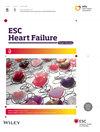Two-year outcomes of a cardiac microcurrent device in chronic heart failure: A first-in-human pilot study
Abstract
Aims
In heart failure patients, altered myocardial electrical fields linked to oedema may impair left ventricular function. While short-term use of implanted microcurrent generators (C-MIC) has shown promise, long-term effects remain unclear. This study assessed the safety and efficacy of C-MIC use beyond the initial 6 month pilot period.
Methods
Patients from the initial C-MIC pilot study who were alive at 6 months were screened for 2 year follow-up. The primary endpoint included rates of all-cause, cardiac- and device-related mortality, all-cause, cardiac and device related hospitalizations, along with adverse events, device malfunctions and exchanges. Secondary endpoints evaluated device performance via left ventricular ejection fraction (LVEF), 6 min walk distance, New York Heart Association (NYHA) class and SF-36 quality-of-life scores and the need for prolonged therapy.
Results
Of the 10 patients enrolled in the initial study, 7 were enrolled in follow-up (mean age 52.4 ± 7.6 years, NYHA Class III and mean LVEF 31.7 ± 3.7%). No device-related adverse events occurred. One non-cardiac, non-device related death was reported at 18 months. Improvement in LVEF of 11.60% [95% confidence interval (CI): 5.64–17.56, P < 0.001] from baseline to 6 months was maintained at 2 years post-C-MIC deactivation, with a sustained increase of 12.56% from baseline (95% CI: 4.67–20.45, P = 0.002). Similarly, the 6 min walk distance improved by 206.35 m at 6 months (95% CI: 161.32–251.39, P < 0.0001) and remained at 191 m above baseline at 2 years (95% CI: 131.83–250.99, P < 0.0001). Improvements in NYHA functional class and SF-36 quality-of-life scores observed at 6 months were also preserved throughout the 2 year follow-up. One patient required C-MIC reactivation.
Conclusions
Long-term use of the C-MIC device appears safe with sustained improvements in NYHA class, LVEF, 6 min walk distance and quality of life, supporting the long-term therapeutic potential of microcurrent therapy.


 求助内容:
求助内容: 应助结果提醒方式:
应助结果提醒方式:


